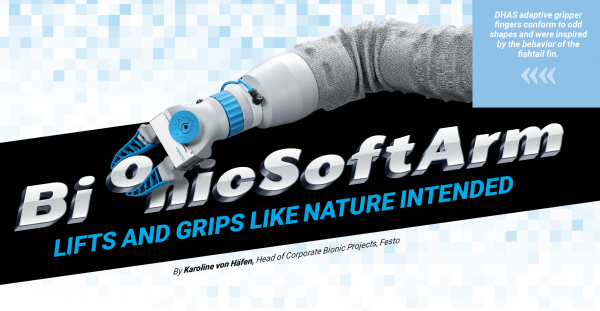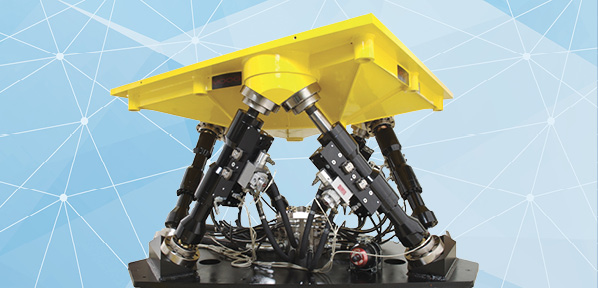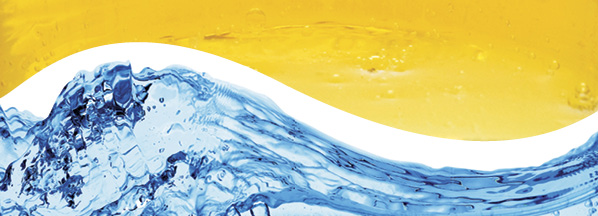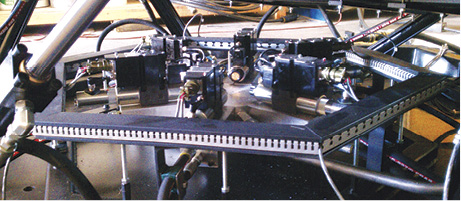The Compressed Air Energy Equation
By Ron Marshall
Something about the compressed-air-system energy equation doesn’t appear to add up. Compared to what goes into the compressors, little energy is delivered at the far end of the system.
Figuring It Out
To realize the impact of this, you must do some calculations. Let’s take a vane-style air motor as an example, the same type of motor that is in any compressed-air-powered hand tool. Perhaps you want to turn a rotary device, using a vane-style motor driven by 90 psi compressed air, and produce one horsepower (hp)of output on the motor shaft. (One horsepower is equivalent to about 0.75 kW of power.) If we look up the air motor specifications, we will find that this motor, when operating, consumes about 30 cubic feet per minute (cfm) of compressed air. This is where it gets interesting. If we look up the specification of a typical air compressor, we might find that the one we want to use is rated at a specific power of 25 kW input for every 100 cfm of compressed air produced. (Specific power is like a gas-mileage rating for compressors, calculating the energy input compared to the flow output.) If we do a little calculating, we find that the 30 cfm required by the one hp air motor will cause the air compressor to consume 7.5 kW, about 10 times as much as the motor power output.

Other Factors to Consider
But the story gets worse! The specific power for a fixed-speed compressor is measured under laboratory conditions on a lossless system with the compressor fully loaded (its most efficient point). This is not typically a real-life situation. In real life, a plant air system has some losses that need to be considered. These losses are due to leakage, pressure drop, and the compressor running under partial load.
Leakage
Most compressed-air systems have various loose fittings, failed hoses, cracks and holes in the piping and components that allow a bit of the compressed air to leak out of the system before it gets to the air motor. Studies have shown that leakage levels average about 30 percent of the average compressed air flow in a typical industrial plant (although this can sometimes be much worse). This makes the compressed air going to the air motor 30 percent more expensive!
Pressure Drop
The filters, piping, hoses and connectors feeding the air motor have a resistance to flow. This resistance causes pressure drop so that to achieve a pressure of 90 psi at the air motor, the compressor pressure must be higher. For example, at 15 psi pressure differential, the air compressor will consume about 7.5 percent more power for the same flow, making the compressed air that feeds the motor even more costly.
Partial Load
If the air motor is being fed using a screw compressor, there is partial load to consider. Screw compressors use various modes of control to be able to feed flows that are less than their capacity without over-pressuring the system. The most common mode is load/unload mode in which the compressor spends a fraction of the time unloaded, still consuming about 35% of full-load power (see Figure 2), but producing no air. For example, a load/unload compressor at 50 percent load with 2 gallons of available storage capacity would consume about 80 percent of its full-load power, boosting the cost to produce the 30 cfm air motor load another 60 percent.
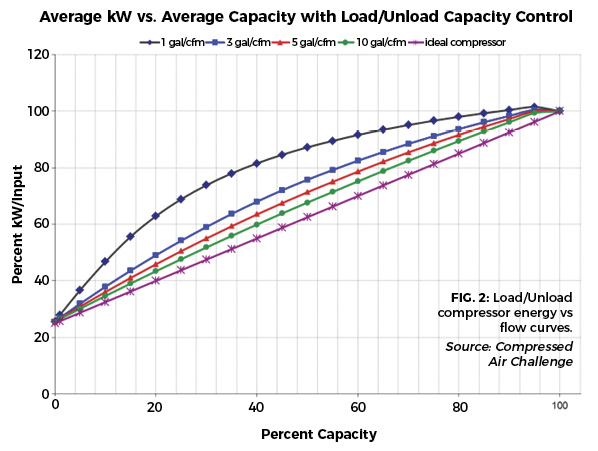
Putting It All Together
So, let’s do the math.
The one-horsepower air motor outputs about 0.75 kW of shaft power. To produce this power:
- A lossless compressor must consume about 7.5 kW (30 x 25/100 = 7.5 kW)
- Leaks increase the power required to 9.75 kW (7.5 kW x 1.3= 9.75 kW).
- Overcoming pressure drop increases the power further to 10.5 kW (9.75 x 1.075 = 10.5 kW).
- And the characteristics of the partly loaded compressor increase the power requirement to 16.8 kW (10.5 x 1.6 = 16.8 kW)
This requirement of 16.8 kW is over 22 times the actual power delivered by the motor! There must be a better way.
Steps To Take
Where does the energy go? Basically up in the air as heat, the biggest product of an air compressor. If that heat could be used, the overall efficiency would be much better.
Can you do anything about this poor efficiency? Yes, consider driving any mechanical load with a more efficient source of energy, such as a direct-drive electric motor, but this may not always be possible. If compressed air must be used, then consider working to repair system leakage, reducing pressure drop by upsizing components, and using an air compressor that can efficiently deal with part loads, such as a variable speed style.
Learn more about compressed air efficiency at one of our Compressed Air Challenge seminars. For a schedule of events see www.compressedairchallenge.org.

